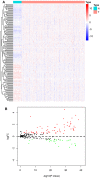Construction and Validation of an Autophagy-Related Prognostic Risk Signature for Survival Predicting in Clear Cell Renal Cell Carcinoma Patients
- PMID: 32432045
- PMCID: PMC7214632
- DOI: 10.3389/fonc.2020.00707
Construction and Validation of an Autophagy-Related Prognostic Risk Signature for Survival Predicting in Clear Cell Renal Cell Carcinoma Patients
Abstract
Background: Clear cell renal cell carcinoma (ccRCC) is a common type of malignant tumors in urinary system. Evaluating the prognostic outcome at the time of initial diagnosis is essential for patients. Autophagy is known to play a significant role in tumors. Here, we attempted to construct an autophagy-related prognostic risk signature based on the expression profile of autophagy-related genes (ARGs) for predicting the long-term outcome and effect of precise treatments for ccRCC patients. Methods: We obtained the expression profile of ccRCC from the cancer genome atlas (TCGA) database and extract the portion of ARGs. We conducted differentially expressed analysis on ARGs and then performed enrichment analyses to confirm the anomalous autophagy-related biological functions. Then, we performed univariate Cox regression to screen out overall survival (OS)-related ARGs. With these genes, we established an autophagy-related risk signature by least absolute shrinkage and selection operator (LASSO) Cox regression. We validated the reliability of the risk signature with receiver operating characteristic (ROC) analysis, survival analysis, clinic correlation analysis, and Cox regression. Then we analyzed the function of each gene in the signature by single-gene gene set enrichment analysis (GSEA). Finally, we analyzed the correlation between our risk score and expression level of several targets of immunotherapy and targeted therapy. Results: We established a seven-gene prognostic risk signature, according to which we could divide patients into high or low risk groups and predict their outcomes. ROC analysis and survival analysis validated the reliability of the signature. Clinic correlation analysis found that the risk group is significantly correlated with severity of ccRCC. Multivariate Cox regression revealed that the risk score could act as an independent predictor for the prognosis of ccRCC patients. Correlation analysis between risk score and targets of precise treatments showed that our risk signature could predict the effects of precise treatment powerfully. Conclusion: Our study provided a brand new autophagy-related seven-gene prognostic risk signature, which could perform as a prognostic indicator for ccRCC. Meanwhile, our study provides a novel sight to understand the role of autophagy and suggest therapeutic strategies in the category of precise treatment in ccRCC.
Keywords: TCGA; autophagy-related genes; clear cell renal cell carcinoma; effect prediction of precise treatments; least absolute shrinkage and selection operator (LASSO) Cox regression; overall survival; prognostic outcome; prognostic risk signature.
Copyright © 2020 Yang, Han and Li.
Figures










Similar articles
-
Construction of Competitive Endogenous RNA Network and Verification of 3-Key LncRNA Signature Associated With Distant Metastasis and Poor Prognosis in Patients With Clear Cell Renal Cell Carcinoma.Front Oncol. 2021 Mar 24;11:640150. doi: 10.3389/fonc.2021.640150. eCollection 2021. Front Oncol. 2021. PMID: 33869028 Free PMC article.
-
Identification of an Autophagy-Related Prognostic Signature for Clear Cell Renal Cell Carcinoma.Front Oncol. 2020 May 29;10:873. doi: 10.3389/fonc.2020.00873. eCollection 2020. Front Oncol. 2020. PMID: 32547955 Free PMC article.
-
Identification and validation of autophagy-related prognostic signature for head and neck squamous cell carcinoma.Transl Oncol. 2021 Jul;14(7):101094. doi: 10.1016/j.tranon.2021.101094. Epub 2021 Apr 18. Transl Oncol. 2021. PMID: 33878525 Free PMC article.
-
A new CCCH-type zinc finger-related lncRNA signature predicts the prognosis of clear cell renal cell carcinoma patients.Front Genet. 2022 Sep 30;13:1034567. doi: 10.3389/fgene.2022.1034567. eCollection 2022. Front Genet. 2022. PMID: 36246657 Free PMC article.
-
Systematic Review of Prognostic Gene Signature in Gastric Cancer Patients.Front Bioeng Biotechnol. 2020 Jul 31;8:805. doi: 10.3389/fbioe.2020.00805. eCollection 2020. Front Bioeng Biotechnol. 2020. PMID: 32850704 Free PMC article.
Cited by
-
Deciphering the tumour microenvironment of clear cell renal cell carcinoma: Prognostic insights from programmed death genes using machine learning.J Cell Mol Med. 2024 Jul;28(13):e18524. doi: 10.1111/jcmm.18524. J Cell Mol Med. 2024. PMID: 39011666 Free PMC article.
-
SPAG9 Expression Predicts Good Prognosis in Patients with Clear-Cell Renal Cell Carcinoma: A Bioinformatics Analysis with Experimental Validation.Genes (Basel). 2023 Apr 20;14(4):944. doi: 10.3390/genes14040944. Genes (Basel). 2023. PMID: 37107702 Free PMC article.
-
Identification of autophagy-related long non-coding RNA prognostic and immune signature for clear cell renal cell carcinoma.Transl Androl Urol. 2021 Aug;10(8):3317-3331. doi: 10.21037/tau-21-278. Transl Androl Urol. 2021. PMID: 34532256 Free PMC article.
-
Prognostic Model and Nomogram Construction and Validation With an Autophagy-Related Gene Signature in Low-Grade Gliomas.Front Genet. 2022 Jul 18;13:905751. doi: 10.3389/fgene.2022.905751. eCollection 2022. Front Genet. 2022. PMID: 35923699 Free PMC article.
-
Construction and validation of an autophagy-related long noncoding RNA signature for prognosis prediction in kidney renal clear cell carcinoma patients.Cancer Med. 2021 Apr;10(7):2359-2369. doi: 10.1002/cam4.3820. Epub 2021 Mar 2. Cancer Med. 2021. PMID: 33650306 Free PMC article.
References
LinkOut - more resources
Full Text Sources

